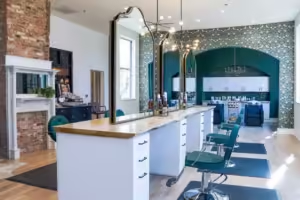Introduction
For many of us, gray hair is an inevitable part of life, and knowing how to deal with it can turn this change into an aesthetic opportunity. Yet for some people, masking gray hair remains a priority. In this article, we'll look at the factors linked to the appearance of grey hair and the reasons why some people choose to camouflage it.
Background to the appearance of grey hair
Causes and biological factors
The appearance of gray hair is mainly caused by the progressive reduction of melanin, the pigment responsible for hair color. This process is often linked to genetic factors and age. Over time, hair follicles produce less and less pigment, giving rise to hair that appears gray, then eventually white.
The psychological and societal impact of gray hair
On a psychological level, the appearance of grey hair can influence self-esteem and be perceived differently depending on culture and social context. In some societies, grey hair is associated with wisdom and experience, while in others it may be interpreted as a sign of aging and diminishing vitality. This phenomenon can affect the personal image and social interactions of many people.
Why mask grey hair
Aesthetic reasons
For many people, the main motivation for masking grey hair is purely financial. aesthetics. Hair color can complement not only skin tone but also personal style. For this reason, masking grey hair is seen by some as a way of maintaining a youthful, dynamic appearance, aligned with their preferred visual identity.
Psychological reasons
Beyond aesthetics, masking gray hair can have significant psychological implications. For some people, this gesture represents a way of feeling a sense of control over the aging process, enabling them to maintain a perception of vitality and energy. An affordable cosmetic treatment such as hair coloring can also significantly improve mood and boost self-esteem.
Personal preferences
Finally, the choice of whether or not to mask gray hair often depends on personal preference. Some will choose to adopt their natural color, aligning themselves more with an approach that accepts natural aging. Others, however, find pleasure and satisfaction in exploring different shades and styles, resulting in regular changes to their hair appearance.
Color principle for masking gray hair
How hair coloring works
Explanation of the coloring process
Hair coloring is a chemical process that modifies the structure of the hair to add artificial pigmentation. When a colorant is applied, it penetrates the hair cuticle and introduces new pigments into the hair cortex. This process often requires the use of ammonia or other chemicals to open the hair cuticle and allow the pigments to set permanently. Thanks to these pigments, it is possible to effectively cover gray hair, giving it a new color that can resemble the hair's natural color or offer a total hair transformation.
The importance of color choice
The choice of color is crucial when it comes to masking gray hair. It's essential to select a shade that harmonizes well with the individual's skin tone and personal style. A color that's too dark can create a harsh contrast, especially if other gray hairs quickly reappear, while one that's too light may not offer the desired coverage. Choosing the right shade creates a natural look that boosts confidence and improves overall appearance. What's more, experts often recommend using products designed specifically for gray hair, as they contain pigments that provide optimal, long-lasting coverage.
Mistakes to avoid when colouring grey hair
Inappropriate choice of color
A common mistake when coloring gray hair is to choose a color that doesn't match your skin tone or the rest of your hair. Opting for a shade too far removed from the natural color can produce an unflattering, artificial effect. It is often advisable to choose a shade slightly lighter than the natural color to create a soft, harmonious contrast. In this sense, calling in a professional colorist can help determine the ideal shade that will enhance each individual's natural characteristics.
Poor color application
Another common mistake is incorrect application of color. Incorrect distribution of the product can result in uneven patches and insufficient coverage of gray hair. It's essential to follow the product instructions carefully and apply the dye evenly, section by section, to ensure that each hair is properly covered. In addition, it's advisable to carry out a pre-test to avoid any allergic reactions or unexpected results. Investing in high-quality products and potentially consulting a professional for application can make all the difference between a satisfactory result and a disappointing one.
See also: Essential oils effective against hair loss
The best shades for masking grey hair
Recommended shades for fair skin tones
Golden blonde
Golden blond is an excellent option for people with fair skin tones looking to mask gray hair. This luminous color offers a natural, harmonious transition from the colors typically associated with lighter skin tones. Golden blond creates a subtle warmth that softens the overall appearance, while adding a sun-kissed glow to the hair. This shade can also soften the strong contrasts often caused by gray hair, creating a fresh, youthful look.
Ash brown
Ash brown is another popular option for fair-skinned people. This shade features cool, neutral tones that harmonize perfectly with pink or bluish skin undertones. Ash brown can provide discreet coverage for gray hair while adding an elegant, contemporary dimension to the head of hair. What's more, its ashy appearance can minimize the appearance of roots, making color touch-ups less frequent. It's a sophisticated, natural choice, ideal for those who prefer an authentic, subtle look.
Recommended shades for medium and dark skin tones
Dark chocolate
For medium to dark skin tones, dark chocolate is a rich, vibrant shade that effectively camouflages gray hair. This color choice complements warmer skin tones beautifully, adding depth and dimension to hair. Dark chocolate is also prized for its ability to add luxurious shine, bringing out the vitality of the color. This timeless choice is perfect for those who desire a refined look with relatively low maintenance, thanks to its compatibility with naturally dark roots.
Honey brown
Honey brown is a warm, welcoming shade that pairs perfectly with deeper skin tones. This color features golden undertones that illuminate the face and provide a flattering contrast against the skin. Honey brown is ideal for those wishing not only to mask gray hair, but also to inject a luminous, lively touch to the hairstyle. What's more, this shade works well when combined with balayage or highlighting techniques, adding movement and texture for a visually captivating effect. Adaptable and seductive, honey brown remains an attractive choice for all seasons.
- To select the best shade, it's crucial to consider not only skin tone, but also personal preferences and lifestyle.
- Consult a professional hairdresser to assess which color would best suit your vision and needs.
- Consider the maintenance required, by choosing shades that make touch-ups easier and extend the life of your color.
Care and maintenance after coloring
The importance of post-coloration hair care
Preserving color intensity
Once gray hair has been masked, it's essential to implement the right care routine to maintain the radiance and intensity of the new color. Washing hair with shampoos specifically formulated for color-treated hair helps prolong the life of pigments. These products often contain moisturizing and protective agents that prevent premature fading due to the sun or frequent use of heated tools.
Hydration and protection
Coloring hair can make it more susceptible to damage and dryness. Using a nourishing conditioner or hair mask every week boosts strand hydration and restores natural softness. In addition to weekly care, applying serums or oils can add an extra layer of protection and shine, helping to maintain healthy, vibrant hair.
Tips for prolonging color
Avoid aggression
Environmental elements, such as UV rays and pollution, can dull hair color. Wearing a hat or using a sun protection spray can minimize these effects. Similarly, limiting excessive use of hair dryers and straighteners helps prolong color by preventing further damage to the hair cuticle.
Regular touch-ups
To maintain a fresh, even look, regular touch-ups may be necessary, especially when gray hair starts to reappear at the roots. Visit your colorist regularly to adjust the shade and ensure even coverage. The timing of touch-ups will depend on the rate of hair growth, but is generally recommended every four to six weeks.
FAQ
What's the best hair color for gray hair?
Permanent coloring is often recommended for complete coverage of gray hair, as it offers long-lasting hold and maximum coverage. However, for those who prefer a less permanent change, temporary solutions such as semi-permanent colorations can be considered.
Does gray hair require special products?
Yes, gray and color-treated hair benefits from shampoos and treatments formulated to prolong color and prevent yellowing. These products also help maintain moisture and reduce breakage.
How can I choose the right shade to cover my grey hair?
To choose the best shade, consider your skin tone and personal style, and consult a color specialist who can offer personalized, professional advice.
Are natural remedies for covering grey hair effective?
Natural remedies like henna can provide temporary gray hair coverage and are a chemical-free alternative, but they don't always offer the same level of coverage as chemical dye.
How can I protect my color-treated hair from the sun?
To protect your color-treated hair from the sun, use UV protection sprays and wear a hat to minimize direct exposure. This will help preserve color vibrancy.





